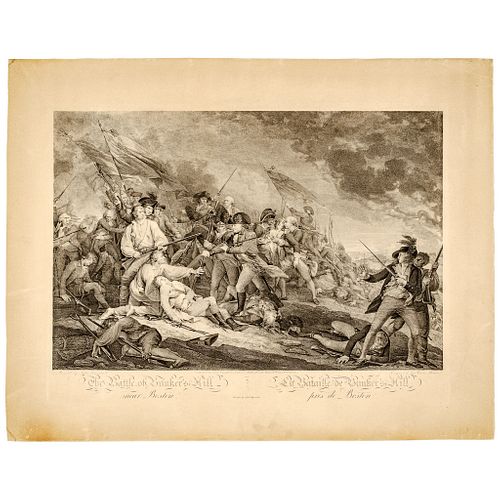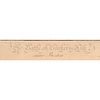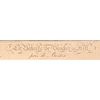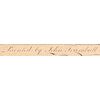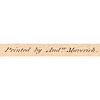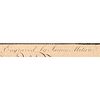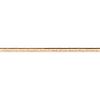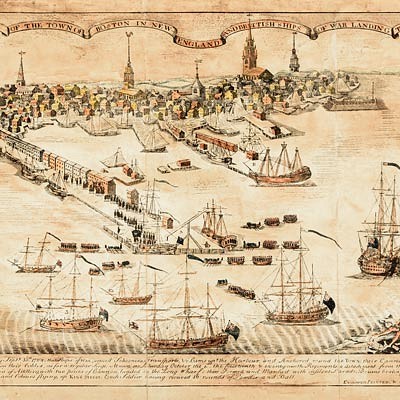1808 Engraving titled The Battle of Bunkers Hill / Near Boston by John Trumbull
Lot 166
Categories
Estimate:
$3,500 - $4,500
Absentee vs Live bid
Two ways to bid:
- Leave a max absentee bid and the platform will bid on your behalf up to your maximum bid during the live auction.
- Bid live during the auction and your bids will be submitted real-time to the auctioneer.
Bid Increments
| Price | Bid Increment |
|---|---|
| $0 | $10 |
| $200 | $20 |
| $300 | $25 |
| $500 | $50 |
| $1,000 | $100 |
| $2,000 | $200 |
| $3,000 | $250 |
| $5,000 | $500 |
| $10,000 | $1,000 |
| $20,000 | $2,000 |
| $30,000 | $2,500 |
| $50,000 | $5,000 |
| $100,000 | $10,000 |
| $200,000 | $20,000 |
| $300,000 | $25,000 |
| $500,000 | $50,000 |
About Auction
By Early American History Auctions
Mar 20, 2021
Set Reminder
2021-03-20 12:00:00
2021-03-20 12:00:00
America/New_York
Bidsquare
Bidsquare : Autographs-Colonial-Political-Americana
https://www.bidsquare.com/auctions/early-american-history-auctions/autographs-colonial-political-americana-6509
330 Lots of Rare, Historic Autographs, Americana, Civil War Era, George Washington, Abraham Lincoln, Slavery & Black History, Revolutionary War Era, Colonial America, Federal Period, War of 1812, Colonial Currency, Indian Peace Medals & more... Early American History Auctions auctions@earlyamerican.com
330 Lots of Rare, Historic Autographs, Americana, Civil War Era, George Washington, Abraham Lincoln, Slavery & Black History, Revolutionary War Era, Colonial America, Federal Period, War of 1812, Colonial Currency, Indian Peace Medals & more... Early American History Auctions auctions@earlyamerican.com
- Lot Description
American Revolution
"The Battle of Bunker's Hill / Near Boston" Historical Steel Engraving Published by John Trumbull
1808-Dated Federal Period, Superb Historical Steel Plate Engraving titled, "The Battle of Bunker's Hill / Near Boston", Engraved by James Mitan, after the original Painting by John Trumbull, Printed by Andrew Maverick, Published by John Trumbull, New York, Choice Crisp Extremely Fine.
This complex, visually impressive historic American Print helped make John Trumbull famous and even decades later, it remained popular with the American public. This engraved version measures about 15" x 20", on a large heavy wove paper print sheet to an overall size of 19.25" x 24.5". This famous Print is ready for framing and display. In this depiction of the Battle of Bunker Hill, artist John Trumbull shows General Joseph Warren dying among a throng of American and British soldiers while Colonel John Chester attempts to save him. It is one of the most iconic images from the American Revolution. Superbly Engraved after the original painting by John Trumbull, it shows the battle scene as the British advance uphill during the famous Battle of Bunker Hill at Charlestown, just outside of Boston. Text below image reads, "Painted by John Trumbull Published by John Trumbull, Jany. 1st, 1808, No. 108 Broad-Way, New York. Engraved by James Mitan / The Battle of Bunker's Hill. Near Boston. Printed by Andw. Maverick." Title is also in French at lower right. Printer Andrew Maverick was the brother of engraver Peter Maverick, also of New York. This example is in original crisp condition having sharp black print on clean heavy wove period art paper. The outer plate impression is still seen slightly embossed into its larger sheet. Printed in 1808, this is an exceptional "museum quality" item, perfect for display, having lovely overall eye appeal. Among the finest examples we have ever encountered.
In late 1785 John Trumbull resolved to devote himself to the depiction of Revolutionary War scenes "which have since been the great objects of my professional life." Benjamin West encouraged Trumbull's objectives, as did Jefferson. From the outset Trumbull intended to paint the pictures so that they could be engraved for sale. Through Benjamin West, Trumbull made the acquaintance of "an Italian artist, by the name of Antonio di Poggi, of very superior talents as a draughtsman, and who had recently commenced the business of publishing."
The first two works that Trumbull completed of the series of eight were The Battle of Bunker's Hill and The Death of General Montgomery in the Attack of Quebec, which were much influenced not only by West, but also by the dramatic action of John Singleton Copley's Death of Chatham (1781) and The Death of Major Pierson (1782-84). Bunker's Hill was begun in 1785 and completed in March 1786; Quebec was begun in February 1785 and finished before Trumbull brought it to Paris in 1786. The Declaration of Independence was begun at Jefferson's house in Paris.
As soon as Bunker's Hill and Quebec were completed, Trumbull tried to find a suitable engraver in London. He was unsuccessful and instead decided to look for an engraver in Paris, where Jefferson had invited him to stay with him at the Htel de Langeac. Finding acceptable engravers for the series proved to be a difficult task. In 1786 Trumbull journeyed through Germany and the Low Countries to look for an engraver. He then returned to London to work on the Declaration of Independence and to begin a new work, The Sortie of the Garrison at Gibralter.
After meeting little success, he went back to the United States in November 1789, traveling everywhere to compile portraits for the historical series. Discouraged, he temporarily abandoned the project in 1793, saying that "my great enterprise was blighted." Trumbull accepted a post with John Jay on the Jay Treaty Commission, and returned to London. While serving there, Bunker's Hill and Quebec were finally published in 1798.
Our Auction Contents:
Black History & Slavery: (Lots 1 - 63)
Abraham Lincoln Related: (Lots 64 - 74)
Historic Autographs: (Lots 75 - 235)
Colonial America: (Lots 236 - 261)
Revolutionary War: (Lots 262 - 304)
George Washington Related: (Lots 305 - 306)
Early American Guns & Weapons: (Lots 307 - 318) - Shipping Info
-
Early American provides in-house worldwide shipping. Please contact us directly if you have questions about your specific shipping requirements.
-
- Buyer's Premium



 EUR
EUR CAD
CAD AUD
AUD GBP
GBP MXN
MXN HKD
HKD CNY
CNY MYR
MYR SEK
SEK SGD
SGD CHF
CHF THB
THB